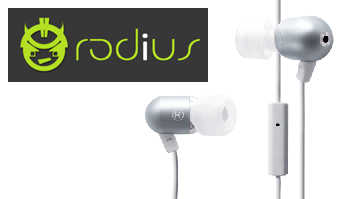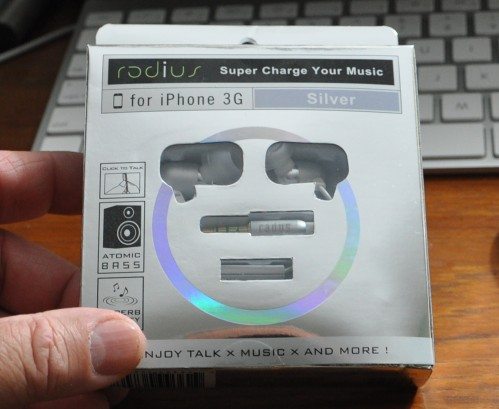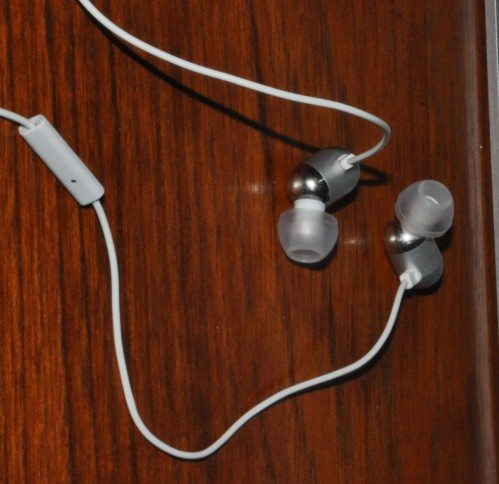
I love music. I love to listen to it loud enough to hear all the details, like the small nuances of those “lesser instruments” that may not be noticed at lower volumes. But I don’t like the sweaty, “ear-itating” over-the-ear design of most “isolation” headsets. One of my college roommates had a set of Koss liquid-cushioned headsets that would put you inside a silent bubble where you could be totally alone with your music. They were great, but after 20-30 minutes, your neck would ache from the weight, and your ears would be sweaty from the lack of circulation.

Enter the modern era of silicone earbuds. This product category started years ago in the music industry, after touring musicians found that hours of loud music night after night was causing hearing loss. They needed to hear their monitor mix without sacrificing the stadium-level sound. Custom-molded earphones (while still available) soon gave way to mass-produced models, with better and more complex audio feeds. I have toyed with getting a set, but balked at the $100 starting point for the lesser models. Sure, there are some models out on the racks at big-box music or discount stores, but I’m not a skateboarder listening to metal or a dancing diva listening to pop. What’s a geezer with an iPhone and musical tastes from classical to country to jazz going to do? Fortunately, an opportunity to test the Radius RK-CA511S Atomic Bass Aluminum Earphones with In-Line Microphone for iPhone came my way from Julie, so let’s consider what they are and what they do.
In the Box
Nothing too spectacular about the packaging, other than it is NOT vacuum sealed into a plastic coffin (Thanks Radius!). The basic vacuum-formed insert into the gleaming reflective sliver cardboard box shows the important parts of the product through a window: two fairly large cylinders with protrusions for ear cups, an inline mic with a pinch-control remote, ending in a low-profile 3.5 mm gold-plated plug. (Low Profile means it will fit into the recess of a first-generation iPhone.) Hidden under the tray is a small plastic bag containing two pairs of different sized silicone earcups and an instruction leaflet smaller than a matchbook, printed in micro-type. They come in black, silver, or maroon finishes. I got the silver, which, I was happy to see, is slightly textured, so no fingerprints show.

Tech Specs (headphones)
Driver Unit – 10mm
neodymium magnet
Sensitivity – 103dB/mW (at 1kHz)
Frequency Response – 20 – 20,000 Hz
Maximum Input 10mW
Impedence 32 ohms
Plug 3.5 mm stereo mini adapter (iPhone compatible)
Cable Length 120 cm
Weight (w/o cable) 8g
Tech Specs (microphone)
Frequency Response – 50 – 20,000 Hz
Polar pattern – omnidirectional
Sensitivity – -42dB (±2 dB)
The most important thing I have always considered with headphones is the frequency response. (If the sounds are not being produced by the device, we can’t hear them, right?) Human hearing averages 10 octaves, from 20 to 20,000 Hz at birth. We rather rapidly lose upper range once we get out in the world of noise, but it’s still a good ballpark range to use. For reference, the tuning note of orchestras in the US, A above middle C, is 440 Hz. One octave is half (or twice) the note above (or below) – so the A below middle C is 220 Hz, while the A an octave above would be 880 Hz. At about 15 Hz, the ear can detect the individual vibrations, so it stops being a tone, and becomes a series of thumps. This is the effect of the “buzz strip” between lanes and on the shoulder of the highway. If they are not perfectly spaced, they will sound as noise, not a tone, so 20 Hz is pretty low. (Music majors at my school had to take Physics of Sound. What a fun course!)
At 20 to 20,000 Hz, the Radius earphones are rated to the full range of hearing, which means they should reliably produce any sounds you are capable of hearing. The silicone cups pull off and can be replaced with one of the other sizes very easily. You can even use a different size for each ear. Once you’ve found the size that fits your ears, prepare to be delighted. Turn your music source down – wa-a-a-ay down – plug them into your ears, and turn your music on. You’ll find that you have to use about half the volume you were using, and you’ll hear with better precision and detail. Suddenly, you’re listening to sounds in your music you never realized were there: bows hitting music stands, audience noises on live cuts, guitarists stepping on effects pedals. It’s quite engrossing, which leads to one thing you really need to take away from this: if you’re doing anything where being aware of your surroundings is important, do not use these earphones! This includes driving, walking or biking in traffic, taking care of toddlers, cooking, etc. Even without sound input, you’re cut off from all but the loudest sounds, and that can be dangerous. (I made the mistake of using them while driving, since I had started a call while walking to my car. I talked for maybe 20 minutes, going through city traffic to the highway, and even though I was consciously making myself pay better attention because of the isolation, I wasn’t prepared for the increase in speed that the loss of road noise enabled. Fortunately, it was shift change for the highway patrol, so I didn’t get a few license points as a reminder!)
I also got a chance to try the Radius earphones while flying cross-country, which can tire out your ears with virtually any listening device. I placed them in after we took off, and as long as I left them in, I never heard an announcement or anything else that wasn’t piped in from my music player. My ears never got that hot, need-some-air feeling, either. When the flight attendant tapped my shoulder to tell me we were landing, she seemed a bit perturbed, but I had been very involved in my own audio bubble and had not heard the pilot’s announcement or hers. Again, these things can make you very disengaged from your immediate environment.
Needless to say, this is far beyond the performance I’ve had with all but the most expensive systems in the past. Even the $200 pair of Sharper Image over-the-ear Quiet Place headphones (which I’ve taken on two overseas flights and used for many movies and hours of music in flight and on the ground) take a back seat to these $50 Radius units. And the fact that they fit into a small mint tin, rather than taking up more room than an SLR camera, means they are more likely to be in your bag when you need a quiet moment.
The iPhone microphone (even though it is mounted on the left earphone’s wire, rather than the right, so that it catches on the seat belt) functions nearly as well as the standard Apple unit for stopping and starting. Double-pinching for skipping ahead, and triple-pinching for replaying is not supported as smoothly. Sometimes the double-pinch will work, but more often than not, it doesn’t. I never got the triple-pinch to work. Also, on more than one occasion, inserting the headphones into my iPhone 3G caused the iPod software to start playing, and no pinches would register to stop it. When a call has already connected, putting in the headphones would sometimes trigger the iPod software to start and disconnect the call. Again, this was not 100% repeatable, but did happen more than once in my testing. Sometimes, it was while the iPhone was being recharged, sometimes not, and sometimes it was in areas that have spotty reception. Unfortunately, I didn’t have a standard set of earbuds handy to see if they would behave the same. I have not had the same issues with this phone with either set of the Apple earbuds I have.
For sound quality and isolation, I give these earphones four and a half stars. They are really fine. On the phone/microphone side, however, I give them three and a half. The mic pinching was inconsistent enough to be irritating, and when it would get in that “not working” state, no amount of coaxing would make it stop. I’d have to pull it out and complete the call with the phone up to my ear. Not a big deal, unless you’re driving in a state that makes handheld mobile phone calls illegal. You’d then have to pull over and finish your call. Overall, four out of five stars.
Gerber Gear 22-47162N Fast Draw Folding Assisted Opening Pocket Knife, Fine Edge, Black
$42.73 (as of December 12, 2025 18:01 GMT -05:00 - More infoProduct prices and availability are accurate as of the date/time indicated and are subject to change. Any price and availability information displayed on [relevant Amazon Site(s), as applicable] at the time of purchase will apply to the purchase of this product.)Gerber Gear EVO Jr. Folding Knife - Serrated Edge [22-41493]
$28.99 (as of December 12, 2025 18:00 GMT -05:00 - More infoProduct prices and availability are accurate as of the date/time indicated and are subject to change. Any price and availability information displayed on [relevant Amazon Site(s), as applicable] at the time of purchase will apply to the purchase of this product.)Product Information
| Price: | $49.99 |
| Manufacturer: | Radius |
| Pros: |
|
| Cons: |
|



Gadgeteer Comment Policy - Please read before commenting
Excellent review! As I’m not an iPhone owner, I can’t really add a great deal of input, but I must say, these do look awesome! A very nice design indeed!
I agree with Jay when he says that you did an excellent review of these head phones. I travel a lot on planes and I no longer bring my bulky Bose QC3 head phones. The only part of this review that I disagree with is that mass-produced silicone ear buds feel as good as a custom fit. I found a company (Earsound Customs) that can retro-fit any model of head phones using impressions of a person’s ears to create a custom fit. This would give you the best of both worlds with this product as you state the frequency response is great and with a custom fit the comfort level would be unsurpassed. Hope this helps.
Thanks for the feedback. Glad you both liked the review. @Wayne, there’s a link to a recent Wired article in the part that covers molded earphones. They cover four models that range in price from $300-$1150, and looking at the Earsound Customs website, they charge about $130 to add that to your iPhone earbuds. The stock silicone cups aren’t bad enough for me to invest that much cash. Good to know there are options out there, though.
I picked up a Radius headphone here in Japan yesterday before reading your excellent review, model number RK-BL511K. It’s shaped slightly different in the back but has the same spec as the one you’ve reviewed. I don’t know if I am the only one but it sounds slightly muffled…treble not being so great, but this could be my ears getting old with age 🙁 The fit seems to be great, but I do feel very isolated when wearing these. The only thing that I would like to see is the volume control. Again, thanks for a great review.
You mention “For sound quality and isolation, I give these earphones four and a half stars” but when compared to what? I find most “so called” sound isolating headphones just don’t do what I would hope. I love my Etymotic ER-6i and my Shure SE210 and SE310 headphones and with the flanged tip I get excellent sound isolation, but yes, at a price. Yes, these Radius are only $50 but how do they compare with “real” sound isolating headphones? Personally, I would rather spend $75 or $100 and get really good isolation and “flat” (not artificially bass-y) sound over $50 with poor isolation and imbalanced sound (many headphones boost the bass response, etc). Please note: I am not saying the Radius have poor sound or isolation, I just think any review of headphones that claims sound isolation should be compared to Shure / Etymotic (and be done in the NYC Subway where I use mine every day).
Many pretend sound isolation buds like the Zagg ZBuds (which are decent headphones), Sony, etc. others work reasonably well walking down the street but in real high noise environments (subway, jackhammer, airplane engine) just don’t isolate enough noise.
Etymotics ER-6i are about $77 (Amazon) and Shure SE110 are $93 (Amazon) but I would encourage you to try these to determine how the Radius (and others) actually perform. I think you might find that the extra $25 or $50 to be money well spent if you spend as much time in headphones in high noise environments as I do.
One caveat when wearing any sound isolating headphone is you really have to seat it properly in your ear – getting a good seal. If you aren’t getting good, crisp sound the problem is probably how you have the bud inserted.